COIT20253 Assessment 1: Big Data's Impact on Retail Industry
VerifiedAdded on 2023/01/19
|12
|3393
|50
Report
AI Summary
This report, prepared for the COIT20253 assessment, examines the transformative impact of big data on the retail industry. It begins with an executive summary and table of contents, followed by an introduction that highlights the increasing importance of data from various sources. The report explores opportunities created by big data, including understanding consumer behavior and buying patterns, and discusses value creation strategies. It delves into the application of big data in areas such as customer behavior analytics, prediction of spending, and personalization of consumer experiences. The report then analyzes the Big Data Value Chain and Porter's Five Forces, illustrating how big data can be leveraged to optimize business, create new revenue streams, and introduce new services. The report also uses Porter’s Value Chain Analysis model and Porter’s Five Forces Analysis model to identify how the four big data business drivers could impact business initiatives. The report concludes by emphasizing the importance of big data for retail companies, with the goal of providing enhanced customer experiences and business insights.
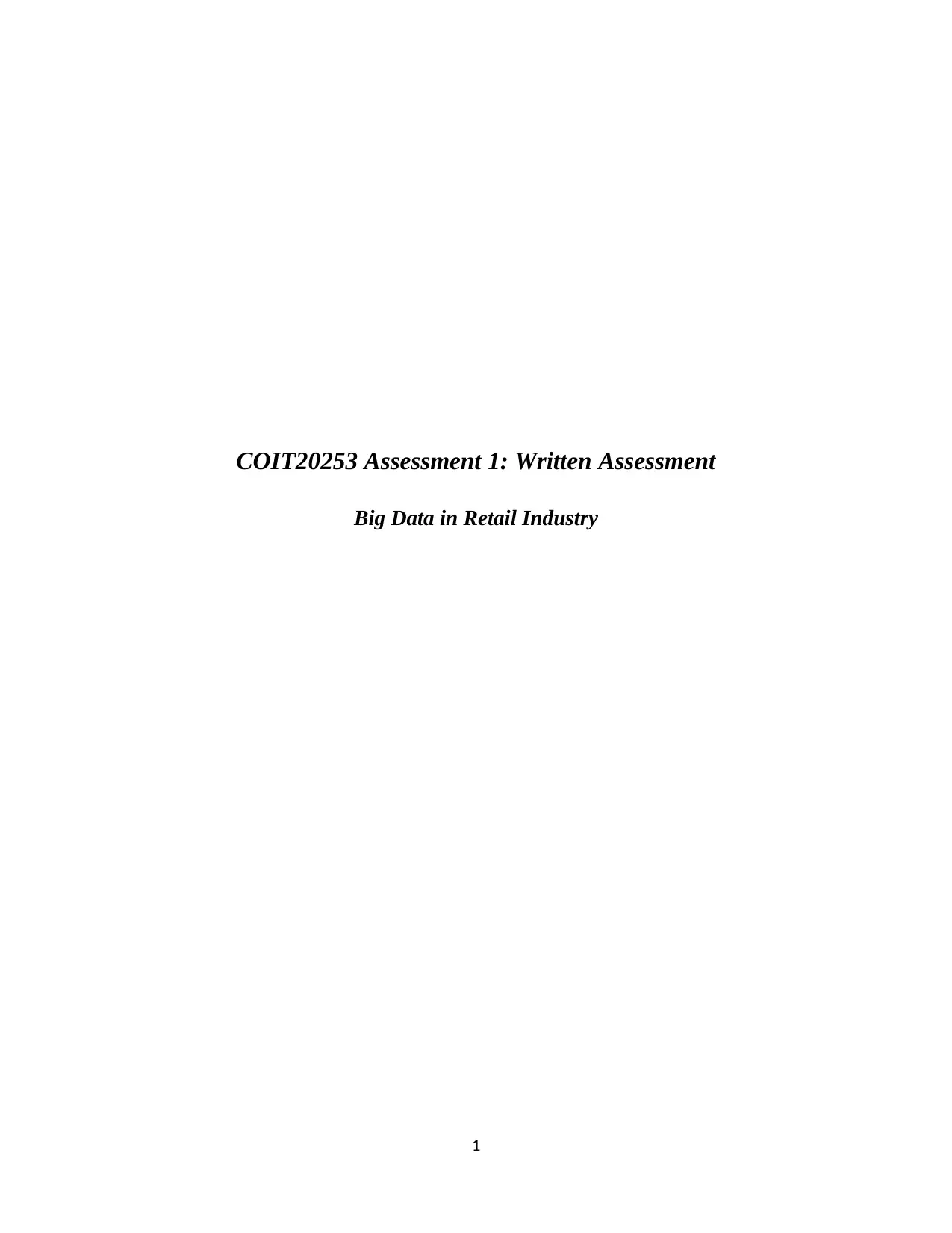
COIT20253 Assessment 1: Written Assessment
Big Data in Retail Industry
1
Big Data in Retail Industry
1
Paraphrase This Document
Need a fresh take? Get an instant paraphrase of this document with our AI Paraphraser
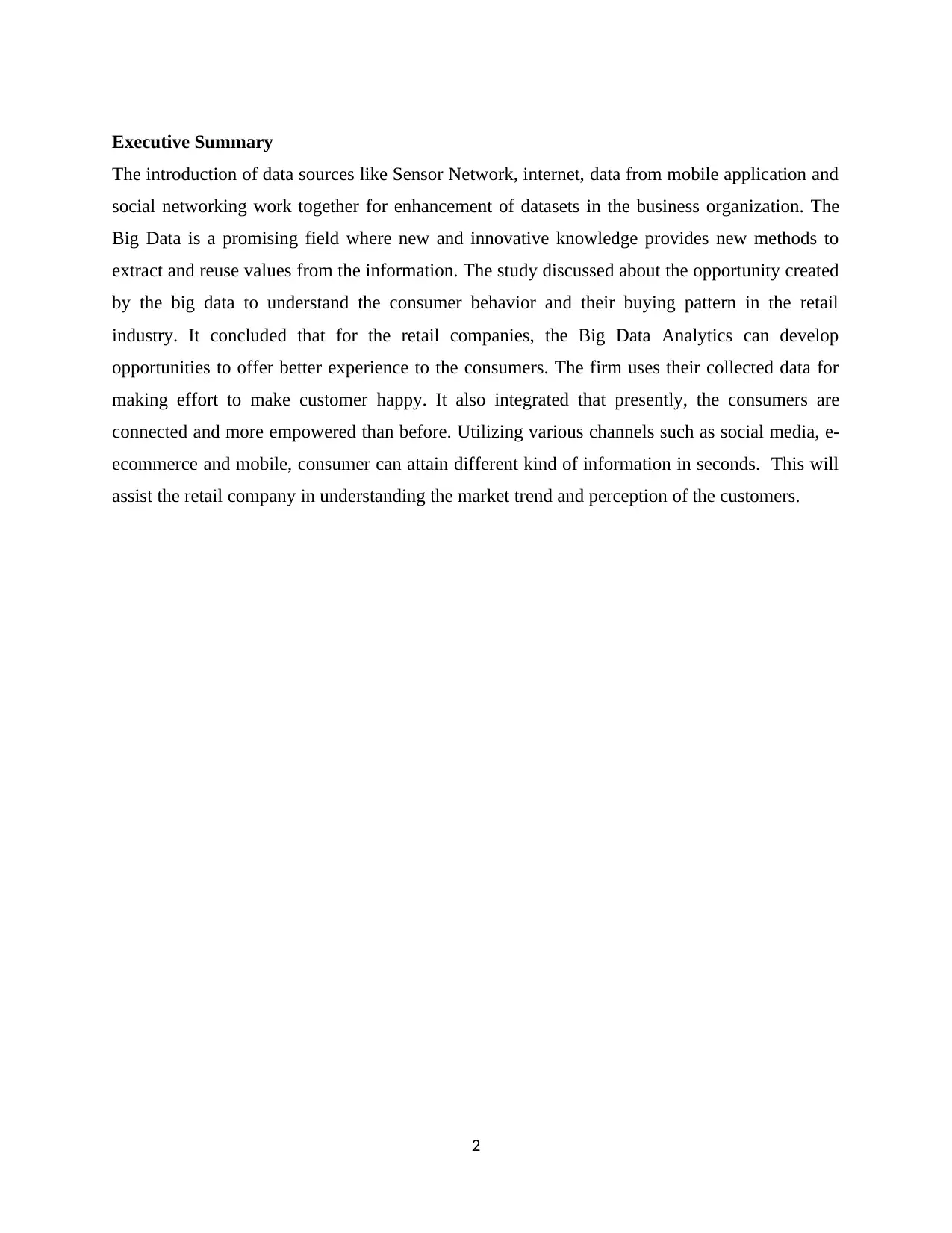
Executive Summary
The introduction of data sources like Sensor Network, internet, data from mobile application and
social networking work together for enhancement of datasets in the business organization. The
Big Data is a promising field where new and innovative knowledge provides new methods to
extract and reuse values from the information. The study discussed about the opportunity created
by the big data to understand the consumer behavior and their buying pattern in the retail
industry. It concluded that for the retail companies, the Big Data Analytics can develop
opportunities to offer better experience to the consumers. The firm uses their collected data for
making effort to make customer happy. It also integrated that presently, the consumers are
connected and more empowered than before. Utilizing various channels such as social media, e-
ecommerce and mobile, consumer can attain different kind of information in seconds. This will
assist the retail company in understanding the market trend and perception of the customers.
2
The introduction of data sources like Sensor Network, internet, data from mobile application and
social networking work together for enhancement of datasets in the business organization. The
Big Data is a promising field where new and innovative knowledge provides new methods to
extract and reuse values from the information. The study discussed about the opportunity created
by the big data to understand the consumer behavior and their buying pattern in the retail
industry. It concluded that for the retail companies, the Big Data Analytics can develop
opportunities to offer better experience to the consumers. The firm uses their collected data for
making effort to make customer happy. It also integrated that presently, the consumers are
connected and more empowered than before. Utilizing various channels such as social media, e-
ecommerce and mobile, consumer can attain different kind of information in seconds. This will
assist the retail company in understanding the market trend and perception of the customers.
2
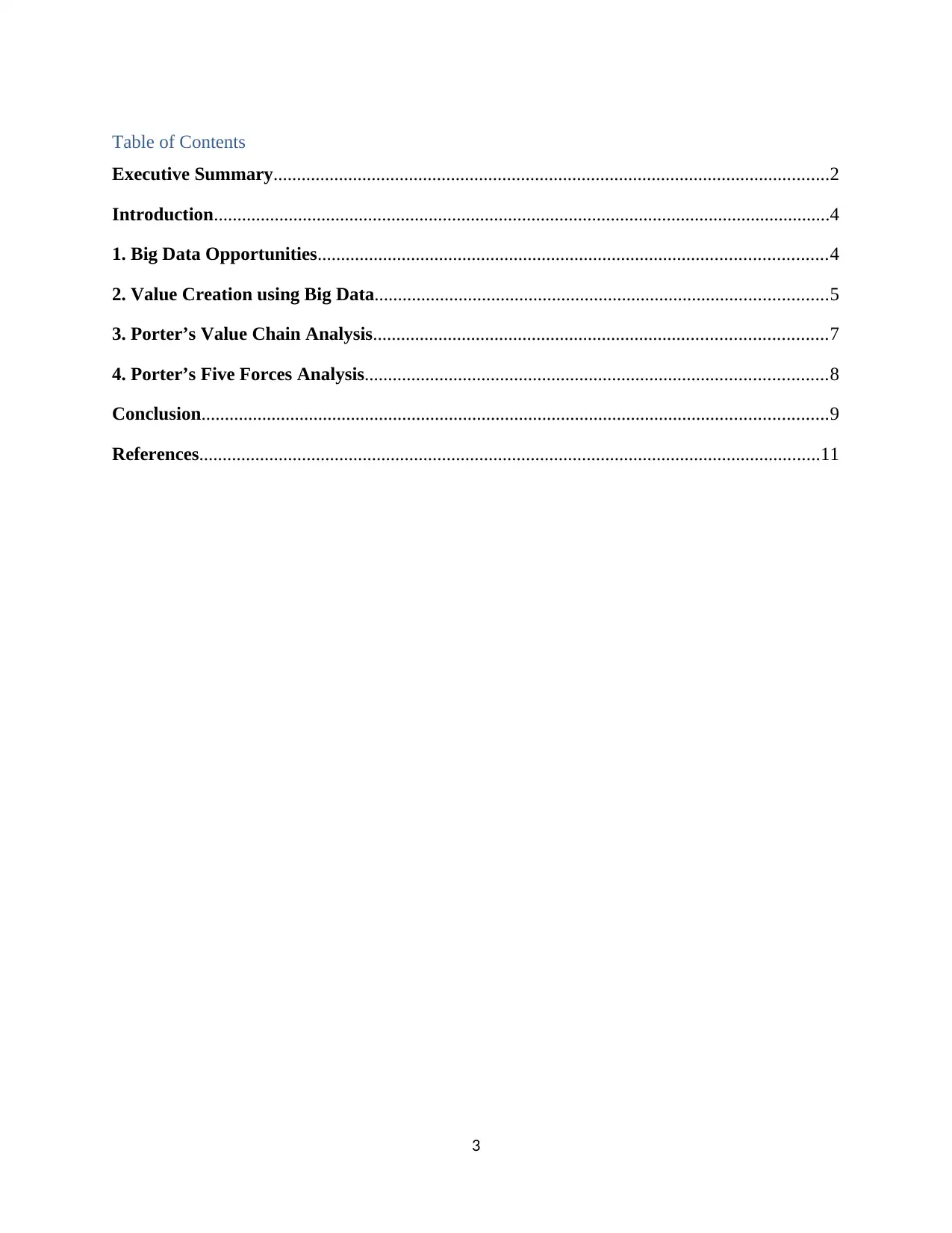
Table of Contents
Executive Summary.......................................................................................................................2
Introduction....................................................................................................................................4
1. Big Data Opportunities.............................................................................................................4
2. Value Creation using Big Data.................................................................................................5
3. Porter’s Value Chain Analysis.................................................................................................7
4. Porter’s Five Forces Analysis...................................................................................................8
Conclusion......................................................................................................................................9
References.....................................................................................................................................11
3
Executive Summary.......................................................................................................................2
Introduction....................................................................................................................................4
1. Big Data Opportunities.............................................................................................................4
2. Value Creation using Big Data.................................................................................................5
3. Porter’s Value Chain Analysis.................................................................................................7
4. Porter’s Five Forces Analysis...................................................................................................8
Conclusion......................................................................................................................................9
References.....................................................................................................................................11
3
⊘ This is a preview!⊘
Do you want full access?
Subscribe today to unlock all pages.

Trusted by 1+ million students worldwide
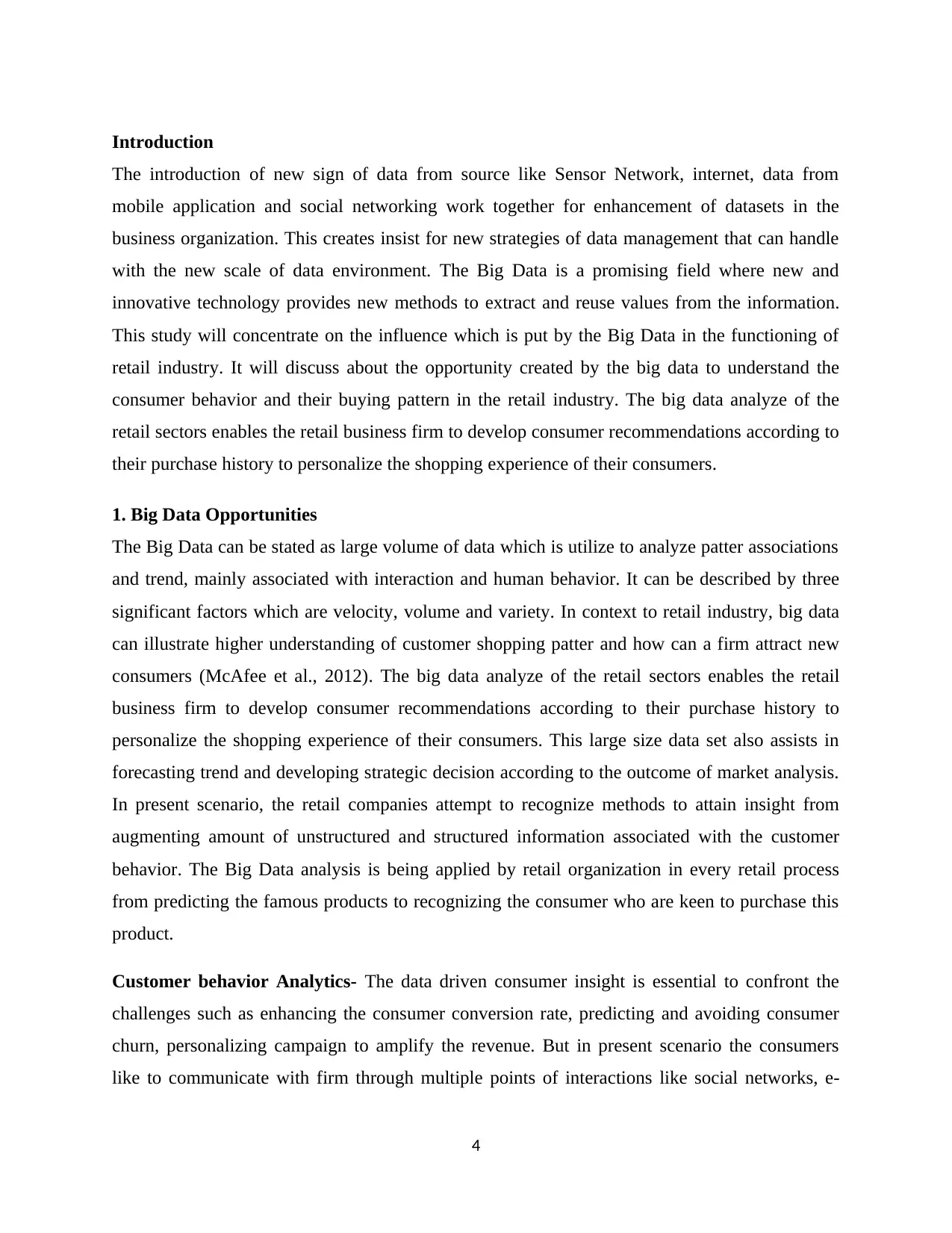
Introduction
The introduction of new sign of data from source like Sensor Network, internet, data from
mobile application and social networking work together for enhancement of datasets in the
business organization. This creates insist for new strategies of data management that can handle
with the new scale of data environment. The Big Data is a promising field where new and
innovative technology provides new methods to extract and reuse values from the information.
This study will concentrate on the influence which is put by the Big Data in the functioning of
retail industry. It will discuss about the opportunity created by the big data to understand the
consumer behavior and their buying pattern in the retail industry. The big data analyze of the
retail sectors enables the retail business firm to develop consumer recommendations according to
their purchase history to personalize the shopping experience of their consumers.
1. Big Data Opportunities
The Big Data can be stated as large volume of data which is utilize to analyze patter associations
and trend, mainly associated with interaction and human behavior. It can be described by three
significant factors which are velocity, volume and variety. In context to retail industry, big data
can illustrate higher understanding of customer shopping patter and how can a firm attract new
consumers (McAfee et al., 2012). The big data analyze of the retail sectors enables the retail
business firm to develop consumer recommendations according to their purchase history to
personalize the shopping experience of their consumers. This large size data set also assists in
forecasting trend and developing strategic decision according to the outcome of market analysis.
In present scenario, the retail companies attempt to recognize methods to attain insight from
augmenting amount of unstructured and structured information associated with the customer
behavior. The Big Data analysis is being applied by retail organization in every retail process
from predicting the famous products to recognizing the consumer who are keen to purchase this
product.
Customer behavior Analytics- The data driven consumer insight is essential to confront the
challenges such as enhancing the consumer conversion rate, predicting and avoiding consumer
churn, personalizing campaign to amplify the revenue. But in present scenario the consumers
like to communicate with firm through multiple points of interactions like social networks, e-
4
The introduction of new sign of data from source like Sensor Network, internet, data from
mobile application and social networking work together for enhancement of datasets in the
business organization. This creates insist for new strategies of data management that can handle
with the new scale of data environment. The Big Data is a promising field where new and
innovative technology provides new methods to extract and reuse values from the information.
This study will concentrate on the influence which is put by the Big Data in the functioning of
retail industry. It will discuss about the opportunity created by the big data to understand the
consumer behavior and their buying pattern in the retail industry. The big data analyze of the
retail sectors enables the retail business firm to develop consumer recommendations according to
their purchase history to personalize the shopping experience of their consumers.
1. Big Data Opportunities
The Big Data can be stated as large volume of data which is utilize to analyze patter associations
and trend, mainly associated with interaction and human behavior. It can be described by three
significant factors which are velocity, volume and variety. In context to retail industry, big data
can illustrate higher understanding of customer shopping patter and how can a firm attract new
consumers (McAfee et al., 2012). The big data analyze of the retail sectors enables the retail
business firm to develop consumer recommendations according to their purchase history to
personalize the shopping experience of their consumers. This large size data set also assists in
forecasting trend and developing strategic decision according to the outcome of market analysis.
In present scenario, the retail companies attempt to recognize methods to attain insight from
augmenting amount of unstructured and structured information associated with the customer
behavior. The Big Data analysis is being applied by retail organization in every retail process
from predicting the famous products to recognizing the consumer who are keen to purchase this
product.
Customer behavior Analytics- The data driven consumer insight is essential to confront the
challenges such as enhancing the consumer conversion rate, predicting and avoiding consumer
churn, personalizing campaign to amplify the revenue. But in present scenario the consumers
like to communicate with firm through multiple points of interactions like social networks, e-
4
Paraphrase This Document
Need a fresh take? Get an instant paraphrase of this document with our AI Paraphraser
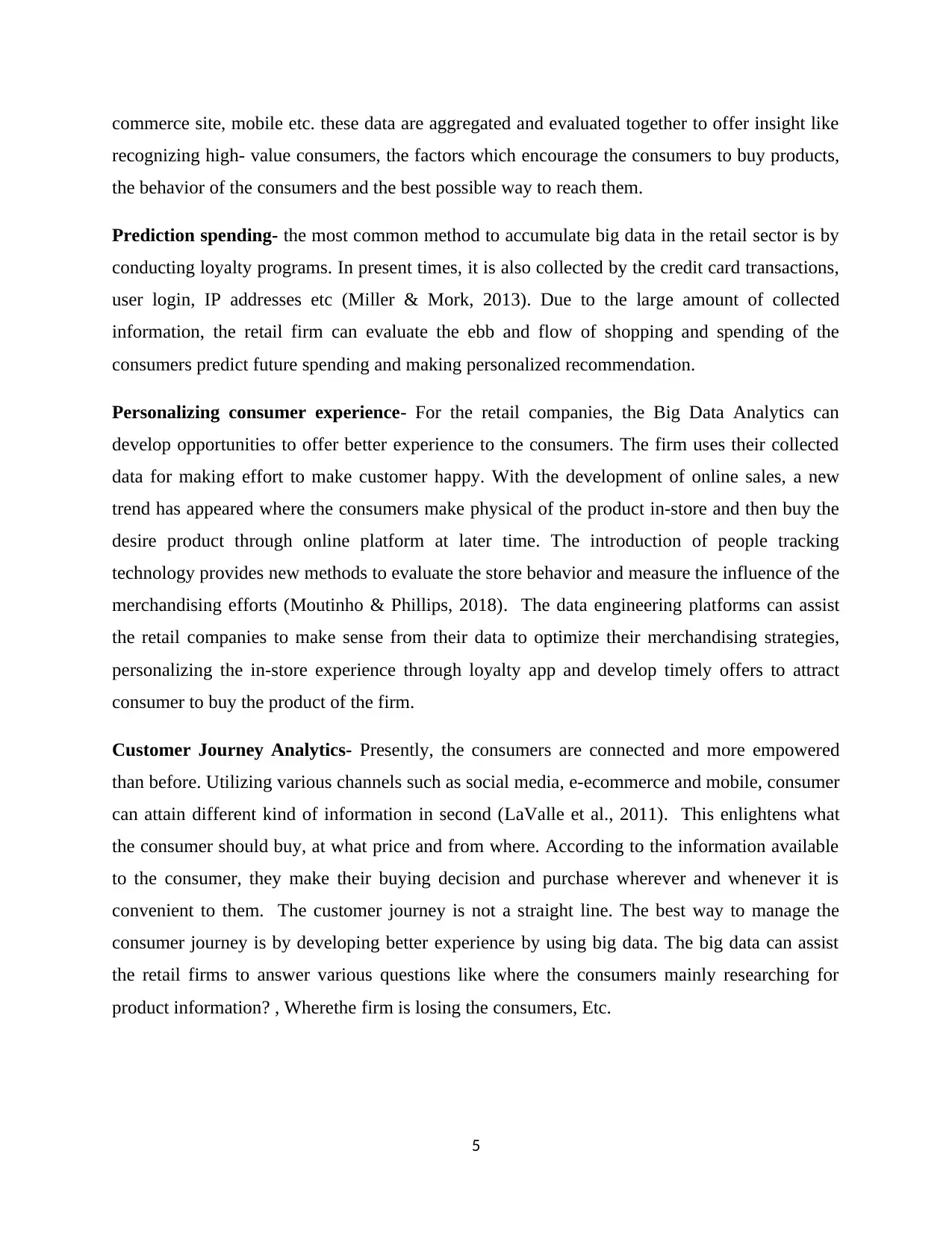
commerce site, mobile etc. these data are aggregated and evaluated together to offer insight like
recognizing high- value consumers, the factors which encourage the consumers to buy products,
the behavior of the consumers and the best possible way to reach them.
Prediction spending- the most common method to accumulate big data in the retail sector is by
conducting loyalty programs. In present times, it is also collected by the credit card transactions,
user login, IP addresses etc (Miller & Mork, 2013). Due to the large amount of collected
information, the retail firm can evaluate the ebb and flow of shopping and spending of the
consumers predict future spending and making personalized recommendation.
Personalizing consumer experience- For the retail companies, the Big Data Analytics can
develop opportunities to offer better experience to the consumers. The firm uses their collected
data for making effort to make customer happy. With the development of online sales, a new
trend has appeared where the consumers make physical of the product in-store and then buy the
desire product through online platform at later time. The introduction of people tracking
technology provides new methods to evaluate the store behavior and measure the influence of the
merchandising efforts (Moutinho & Phillips, 2018). The data engineering platforms can assist
the retail companies to make sense from their data to optimize their merchandising strategies,
personalizing the in-store experience through loyalty app and develop timely offers to attract
consumer to buy the product of the firm.
Customer Journey Analytics- Presently, the consumers are connected and more empowered
than before. Utilizing various channels such as social media, e-ecommerce and mobile, consumer
can attain different kind of information in second (LaValle et al., 2011). This enlightens what
the consumer should buy, at what price and from where. According to the information available
to the consumer, they make their buying decision and purchase wherever and whenever it is
convenient to them. The customer journey is not a straight line. The best way to manage the
consumer journey is by developing better experience by using big data. The big data can assist
the retail firms to answer various questions like where the consumers mainly researching for
product information? , Wherethe firm is losing the consumers, Etc.
5
recognizing high- value consumers, the factors which encourage the consumers to buy products,
the behavior of the consumers and the best possible way to reach them.
Prediction spending- the most common method to accumulate big data in the retail sector is by
conducting loyalty programs. In present times, it is also collected by the credit card transactions,
user login, IP addresses etc (Miller & Mork, 2013). Due to the large amount of collected
information, the retail firm can evaluate the ebb and flow of shopping and spending of the
consumers predict future spending and making personalized recommendation.
Personalizing consumer experience- For the retail companies, the Big Data Analytics can
develop opportunities to offer better experience to the consumers. The firm uses their collected
data for making effort to make customer happy. With the development of online sales, a new
trend has appeared where the consumers make physical of the product in-store and then buy the
desire product through online platform at later time. The introduction of people tracking
technology provides new methods to evaluate the store behavior and measure the influence of the
merchandising efforts (Moutinho & Phillips, 2018). The data engineering platforms can assist
the retail companies to make sense from their data to optimize their merchandising strategies,
personalizing the in-store experience through loyalty app and develop timely offers to attract
consumer to buy the product of the firm.
Customer Journey Analytics- Presently, the consumers are connected and more empowered
than before. Utilizing various channels such as social media, e-ecommerce and mobile, consumer
can attain different kind of information in second (LaValle et al., 2011). This enlightens what
the consumer should buy, at what price and from where. According to the information available
to the consumer, they make their buying decision and purchase wherever and whenever it is
convenient to them. The customer journey is not a straight line. The best way to manage the
consumer journey is by developing better experience by using big data. The big data can assist
the retail firms to answer various questions like where the consumers mainly researching for
product information? , Wherethe firm is losing the consumers, Etc.
5
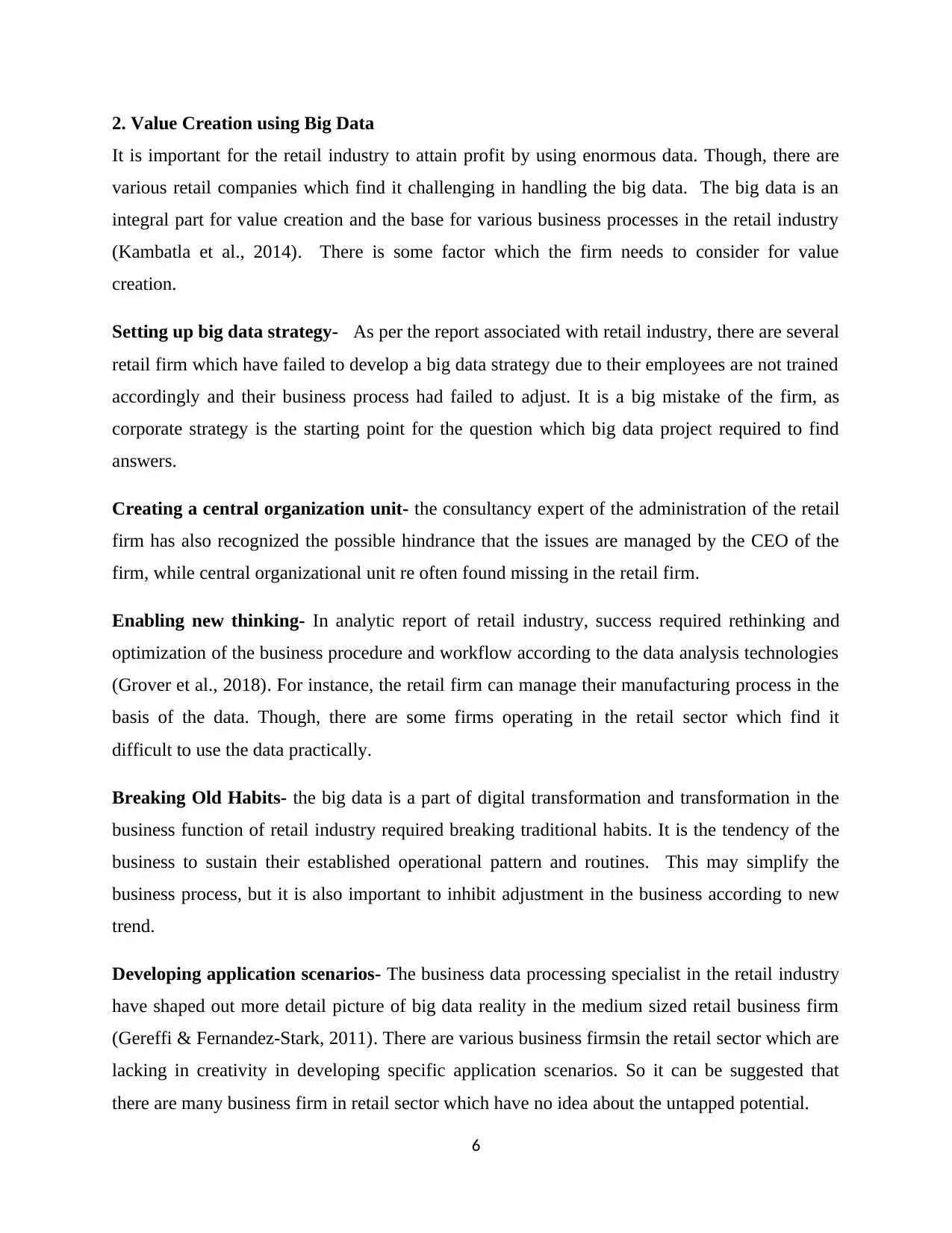
2. Value Creation using Big Data
It is important for the retail industry to attain profit by using enormous data. Though, there are
various retail companies which find it challenging in handling the big data. The big data is an
integral part for value creation and the base for various business processes in the retail industry
(Kambatla et al., 2014). There is some factor which the firm needs to consider for value
creation.
Setting up big data strategy- As per the report associated with retail industry, there are several
retail firm which have failed to develop a big data strategy due to their employees are not trained
accordingly and their business process had failed to adjust. It is a big mistake of the firm, as
corporate strategy is the starting point for the question which big data project required to find
answers.
Creating a central organization unit- the consultancy expert of the administration of the retail
firm has also recognized the possible hindrance that the issues are managed by the CEO of the
firm, while central organizational unit re often found missing in the retail firm.
Enabling new thinking- In analytic report of retail industry, success required rethinking and
optimization of the business procedure and workflow according to the data analysis technologies
(Grover et al., 2018). For instance, the retail firm can manage their manufacturing process in the
basis of the data. Though, there are some firms operating in the retail sector which find it
difficult to use the data practically.
Breaking Old Habits- the big data is a part of digital transformation and transformation in the
business function of retail industry required breaking traditional habits. It is the tendency of the
business to sustain their established operational pattern and routines. This may simplify the
business process, but it is also important to inhibit adjustment in the business according to new
trend.
Developing application scenarios- The business data processing specialist in the retail industry
have shaped out more detail picture of big data reality in the medium sized retail business firm
(Gereffi & Fernandez-Stark, 2011). There are various business firmsin the retail sector which are
lacking in creativity in developing specific application scenarios. So it can be suggested that
there are many business firm in retail sector which have no idea about the untapped potential.
6
It is important for the retail industry to attain profit by using enormous data. Though, there are
various retail companies which find it challenging in handling the big data. The big data is an
integral part for value creation and the base for various business processes in the retail industry
(Kambatla et al., 2014). There is some factor which the firm needs to consider for value
creation.
Setting up big data strategy- As per the report associated with retail industry, there are several
retail firm which have failed to develop a big data strategy due to their employees are not trained
accordingly and their business process had failed to adjust. It is a big mistake of the firm, as
corporate strategy is the starting point for the question which big data project required to find
answers.
Creating a central organization unit- the consultancy expert of the administration of the retail
firm has also recognized the possible hindrance that the issues are managed by the CEO of the
firm, while central organizational unit re often found missing in the retail firm.
Enabling new thinking- In analytic report of retail industry, success required rethinking and
optimization of the business procedure and workflow according to the data analysis technologies
(Grover et al., 2018). For instance, the retail firm can manage their manufacturing process in the
basis of the data. Though, there are some firms operating in the retail sector which find it
difficult to use the data practically.
Breaking Old Habits- the big data is a part of digital transformation and transformation in the
business function of retail industry required breaking traditional habits. It is the tendency of the
business to sustain their established operational pattern and routines. This may simplify the
business process, but it is also important to inhibit adjustment in the business according to new
trend.
Developing application scenarios- The business data processing specialist in the retail industry
have shaped out more detail picture of big data reality in the medium sized retail business firm
(Gereffi & Fernandez-Stark, 2011). There are various business firmsin the retail sector which are
lacking in creativity in developing specific application scenarios. So it can be suggested that
there are many business firm in retail sector which have no idea about the untapped potential.
6
⊘ This is a preview!⊘
Do you want full access?
Subscribe today to unlock all pages.

Trusted by 1+ million students worldwide
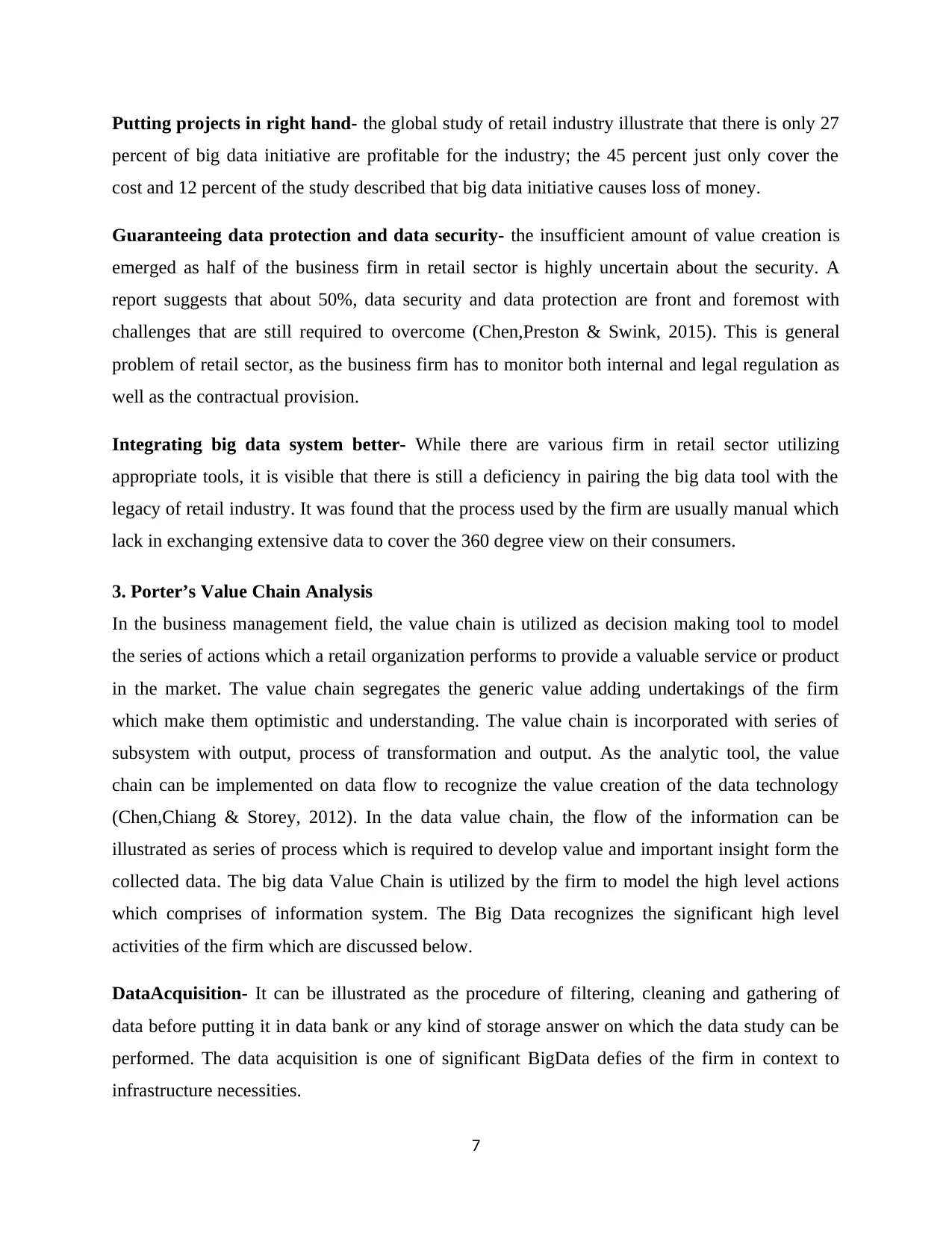
Putting projects in right hand- the global study of retail industry illustrate that there is only 27
percent of big data initiative are profitable for the industry; the 45 percent just only cover the
cost and 12 percent of the study described that big data initiative causes loss of money.
Guaranteeing data protection and data security- the insufficient amount of value creation is
emerged as half of the business firm in retail sector is highly uncertain about the security. A
report suggests that about 50%, data security and data protection are front and foremost with
challenges that are still required to overcome (Chen,Preston & Swink, 2015). This is general
problem of retail sector, as the business firm has to monitor both internal and legal regulation as
well as the contractual provision.
Integrating big data system better- While there are various firm in retail sector utilizing
appropriate tools, it is visible that there is still a deficiency in pairing the big data tool with the
legacy of retail industry. It was found that the process used by the firm are usually manual which
lack in exchanging extensive data to cover the 360 degree view on their consumers.
3. Porter’s Value Chain Analysis
In the business management field, the value chain is utilized as decision making tool to model
the series of actions which a retail organization performs to provide a valuable service or product
in the market. The value chain segregates the generic value adding undertakings of the firm
which make them optimistic and understanding. The value chain is incorporated with series of
subsystem with output, process of transformation and output. As the analytic tool, the value
chain can be implemented on data flow to recognize the value creation of the data technology
(Chen,Chiang & Storey, 2012). In the data value chain, the flow of the information can be
illustrated as series of process which is required to develop value and important insight form the
collected data. The big data Value Chain is utilized by the firm to model the high level actions
which comprises of information system. The Big Data recognizes the significant high level
activities of the firm which are discussed below.
DataAcquisition- It can be illustrated as the procedure of filtering, cleaning and gathering of
data before putting it in data bank or any kind of storage answer on which the data study can be
performed. The data acquisition is one of significant BigData defies of the firm in context to
infrastructure necessities.
7
percent of big data initiative are profitable for the industry; the 45 percent just only cover the
cost and 12 percent of the study described that big data initiative causes loss of money.
Guaranteeing data protection and data security- the insufficient amount of value creation is
emerged as half of the business firm in retail sector is highly uncertain about the security. A
report suggests that about 50%, data security and data protection are front and foremost with
challenges that are still required to overcome (Chen,Preston & Swink, 2015). This is general
problem of retail sector, as the business firm has to monitor both internal and legal regulation as
well as the contractual provision.
Integrating big data system better- While there are various firm in retail sector utilizing
appropriate tools, it is visible that there is still a deficiency in pairing the big data tool with the
legacy of retail industry. It was found that the process used by the firm are usually manual which
lack in exchanging extensive data to cover the 360 degree view on their consumers.
3. Porter’s Value Chain Analysis
In the business management field, the value chain is utilized as decision making tool to model
the series of actions which a retail organization performs to provide a valuable service or product
in the market. The value chain segregates the generic value adding undertakings of the firm
which make them optimistic and understanding. The value chain is incorporated with series of
subsystem with output, process of transformation and output. As the analytic tool, the value
chain can be implemented on data flow to recognize the value creation of the data technology
(Chen,Chiang & Storey, 2012). In the data value chain, the flow of the information can be
illustrated as series of process which is required to develop value and important insight form the
collected data. The big data Value Chain is utilized by the firm to model the high level actions
which comprises of information system. The Big Data recognizes the significant high level
activities of the firm which are discussed below.
DataAcquisition- It can be illustrated as the procedure of filtering, cleaning and gathering of
data before putting it in data bank or any kind of storage answer on which the data study can be
performed. The data acquisition is one of significant BigData defies of the firm in context to
infrastructure necessities.
7
Paraphrase This Document
Need a fresh take? Get an instant paraphrase of this document with our AI Paraphraser
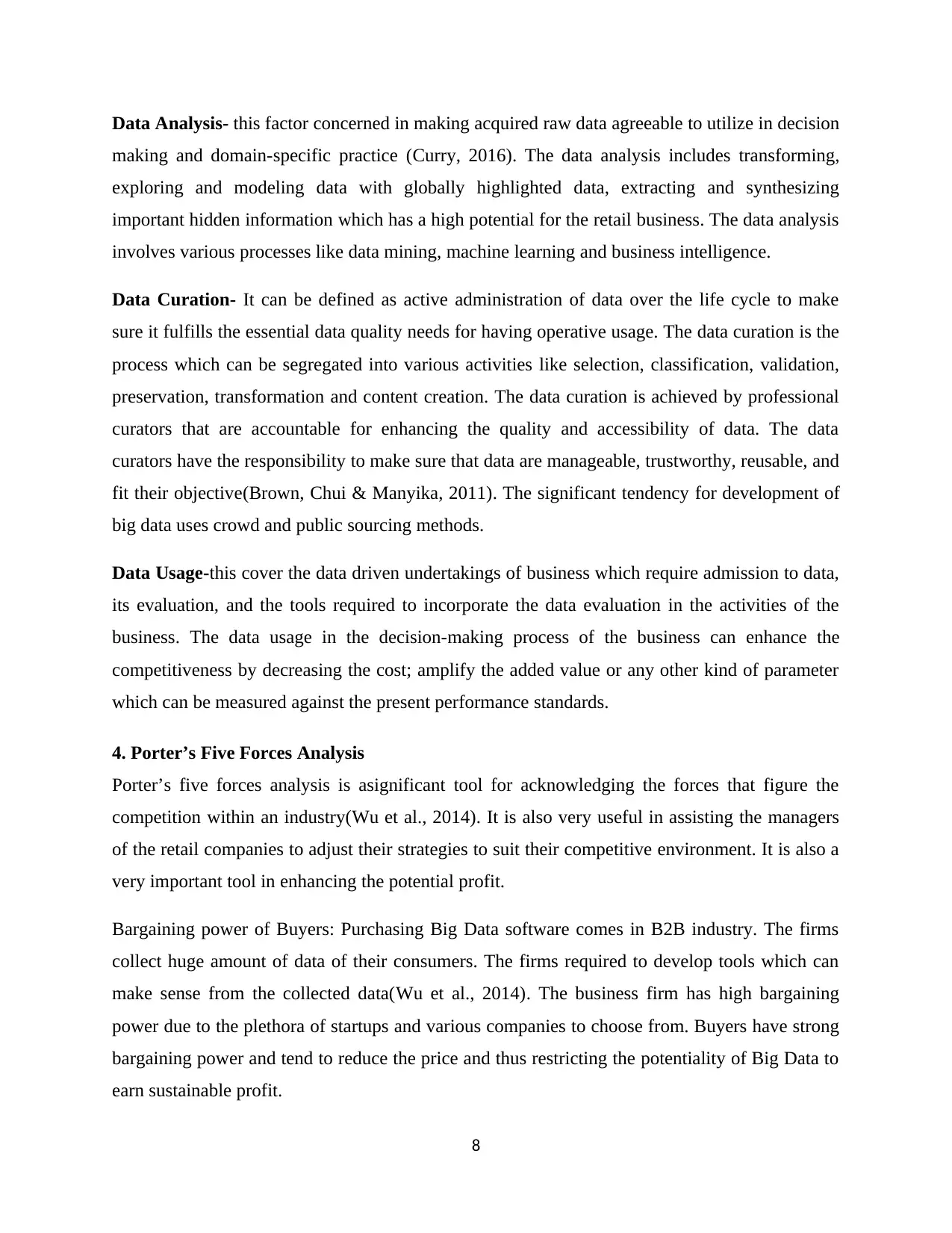
Data Analysis- this factor concerned in making acquired raw data agreeable to utilize in decision
making and domain-specific practice (Curry, 2016). The data analysis includes transforming,
exploring and modeling data with globally highlighted data, extracting and synthesizing
important hidden information which has a high potential for the retail business. The data analysis
involves various processes like data mining, machine learning and business intelligence.
Data Curation- It can be defined as active administration of data over the life cycle to make
sure it fulfills the essential data quality needs for having operative usage. The data curation is the
process which can be segregated into various activities like selection, classification, validation,
preservation, transformation and content creation. The data curation is achieved by professional
curators that are accountable for enhancing the quality and accessibility of data. The data
curators have the responsibility to make sure that data are manageable, trustworthy, reusable, and
fit their objective(Brown, Chui & Manyika, 2011). The significant tendency for development of
big data uses crowd and public sourcing methods.
Data Usage-this cover the data driven undertakings of business which require admission to data,
its evaluation, and the tools required to incorporate the data evaluation in the activities of the
business. The data usage in the decision-making process of the business can enhance the
competitiveness by decreasing the cost; amplify the added value or any other kind of parameter
which can be measured against the present performance standards.
4. Porter’s Five Forces Analysis
Porter’s five forces analysis is asignificant tool for acknowledging the forces that figure the
competition within an industry(Wu et al., 2014). It is also very useful in assisting the managers
of the retail companies to adjust their strategies to suit their competitive environment. It is also a
very important tool in enhancing the potential profit.
Bargaining power of Buyers: Purchasing Big Data software comes in B2B industry. The firms
collect huge amount of data of their consumers. The firms required to develop tools which can
make sense from the collected data(Wu et al., 2014). The business firm has high bargaining
power due to the plethora of startups and various companies to choose from. Buyers have strong
bargaining power and tend to reduce the price and thus restricting the potentiality of Big Data to
earn sustainable profit.
8
making and domain-specific practice (Curry, 2016). The data analysis includes transforming,
exploring and modeling data with globally highlighted data, extracting and synthesizing
important hidden information which has a high potential for the retail business. The data analysis
involves various processes like data mining, machine learning and business intelligence.
Data Curation- It can be defined as active administration of data over the life cycle to make
sure it fulfills the essential data quality needs for having operative usage. The data curation is the
process which can be segregated into various activities like selection, classification, validation,
preservation, transformation and content creation. The data curation is achieved by professional
curators that are accountable for enhancing the quality and accessibility of data. The data
curators have the responsibility to make sure that data are manageable, trustworthy, reusable, and
fit their objective(Brown, Chui & Manyika, 2011). The significant tendency for development of
big data uses crowd and public sourcing methods.
Data Usage-this cover the data driven undertakings of business which require admission to data,
its evaluation, and the tools required to incorporate the data evaluation in the activities of the
business. The data usage in the decision-making process of the business can enhance the
competitiveness by decreasing the cost; amplify the added value or any other kind of parameter
which can be measured against the present performance standards.
4. Porter’s Five Forces Analysis
Porter’s five forces analysis is asignificant tool for acknowledging the forces that figure the
competition within an industry(Wu et al., 2014). It is also very useful in assisting the managers
of the retail companies to adjust their strategies to suit their competitive environment. It is also a
very important tool in enhancing the potential profit.
Bargaining power of Buyers: Purchasing Big Data software comes in B2B industry. The firms
collect huge amount of data of their consumers. The firms required to develop tools which can
make sense from the collected data(Wu et al., 2014). The business firm has high bargaining
power due to the plethora of startups and various companies to choose from. Buyers have strong
bargaining power and tend to reduce the price and thus restricting the potentiality of Big Data to
earn sustainable profit.
8
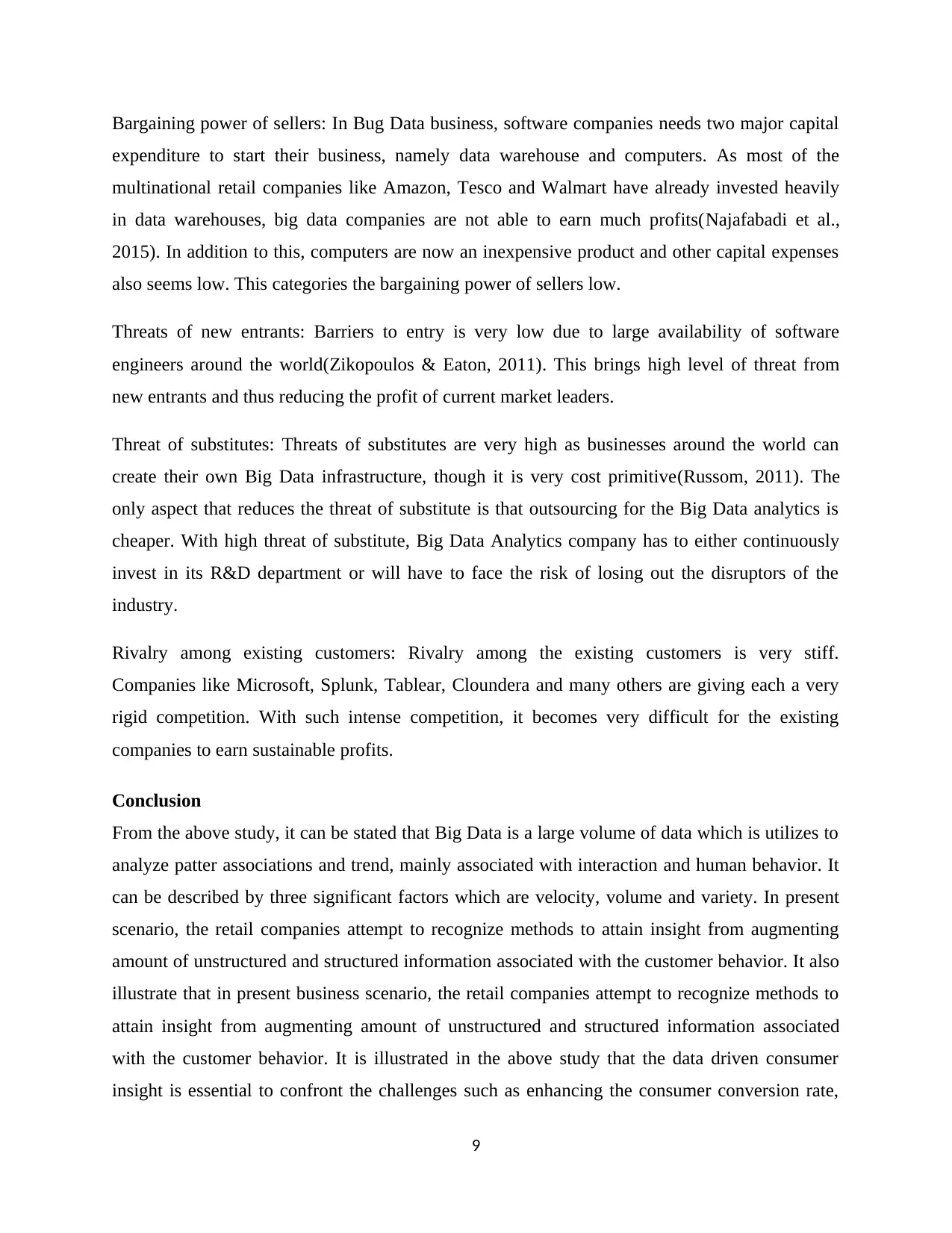
Bargaining power of sellers: In Bug Data business, software companies needs two major capital
expenditure to start their business, namely data warehouse and computers. As most of the
multinational retail companies like Amazon, Tesco and Walmart have already invested heavily
in data warehouses, big data companies are not able to earn much profits(Najafabadi et al.,
2015). In addition to this, computers are now an inexpensive product and other capital expenses
also seems low. This categories the bargaining power of sellers low.
Threats of new entrants: Barriers to entry is very low due to large availability of software
engineers around the world(Zikopoulos & Eaton, 2011). This brings high level of threat from
new entrants and thus reducing the profit of current market leaders.
Threat of substitutes: Threats of substitutes are very high as businesses around the world can
create their own Big Data infrastructure, though it is very cost primitive(Russom, 2011). The
only aspect that reduces the threat of substitute is that outsourcing for the Big Data analytics is
cheaper. With high threat of substitute, Big Data Analytics company has to either continuously
invest in its R&D department or will have to face the risk of losing out the disruptors of the
industry.
Rivalry among existing customers: Rivalry among the existing customers is very stiff.
Companies like Microsoft, Splunk, Tablear, Cloundera and many others are giving each a very
rigid competition. With such intense competition, it becomes very difficult for the existing
companies to earn sustainable profits.
Conclusion
From the above study, it can be stated that Big Data is a large volume of data which is utilizes to
analyze patter associations and trend, mainly associated with interaction and human behavior. It
can be described by three significant factors which are velocity, volume and variety. In present
scenario, the retail companies attempt to recognize methods to attain insight from augmenting
amount of unstructured and structured information associated with the customer behavior. It also
illustrate that in present business scenario, the retail companies attempt to recognize methods to
attain insight from augmenting amount of unstructured and structured information associated
with the customer behavior. It is illustrated in the above study that the data driven consumer
insight is essential to confront the challenges such as enhancing the consumer conversion rate,
9
expenditure to start their business, namely data warehouse and computers. As most of the
multinational retail companies like Amazon, Tesco and Walmart have already invested heavily
in data warehouses, big data companies are not able to earn much profits(Najafabadi et al.,
2015). In addition to this, computers are now an inexpensive product and other capital expenses
also seems low. This categories the bargaining power of sellers low.
Threats of new entrants: Barriers to entry is very low due to large availability of software
engineers around the world(Zikopoulos & Eaton, 2011). This brings high level of threat from
new entrants and thus reducing the profit of current market leaders.
Threat of substitutes: Threats of substitutes are very high as businesses around the world can
create their own Big Data infrastructure, though it is very cost primitive(Russom, 2011). The
only aspect that reduces the threat of substitute is that outsourcing for the Big Data analytics is
cheaper. With high threat of substitute, Big Data Analytics company has to either continuously
invest in its R&D department or will have to face the risk of losing out the disruptors of the
industry.
Rivalry among existing customers: Rivalry among the existing customers is very stiff.
Companies like Microsoft, Splunk, Tablear, Cloundera and many others are giving each a very
rigid competition. With such intense competition, it becomes very difficult for the existing
companies to earn sustainable profits.
Conclusion
From the above study, it can be stated that Big Data is a large volume of data which is utilizes to
analyze patter associations and trend, mainly associated with interaction and human behavior. It
can be described by three significant factors which are velocity, volume and variety. In present
scenario, the retail companies attempt to recognize methods to attain insight from augmenting
amount of unstructured and structured information associated with the customer behavior. It also
illustrate that in present business scenario, the retail companies attempt to recognize methods to
attain insight from augmenting amount of unstructured and structured information associated
with the customer behavior. It is illustrated in the above study that the data driven consumer
insight is essential to confront the challenges such as enhancing the consumer conversion rate,
9
⊘ This is a preview!⊘
Do you want full access?
Subscribe today to unlock all pages.

Trusted by 1+ million students worldwide

predicting and avoiding consumer churn, personalizing campaign to amplify the revenue. But in
present scenario the consumers like to communicate with firm through multiple points of
interactions like social networks, e-commerce site, mobile etc.
10
present scenario the consumers like to communicate with firm through multiple points of
interactions like social networks, e-commerce site, mobile etc.
10
Paraphrase This Document
Need a fresh take? Get an instant paraphrase of this document with our AI Paraphraser
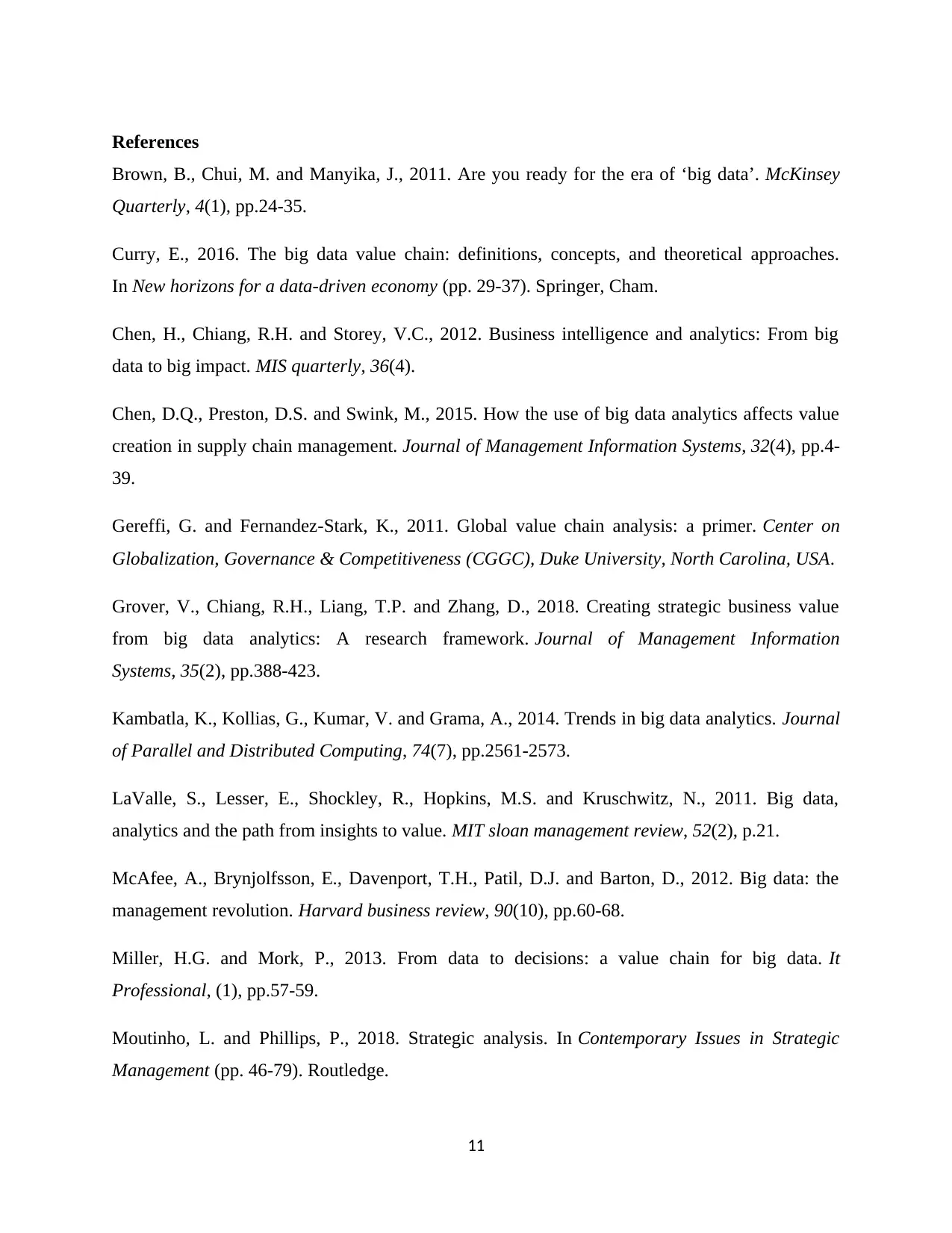
References
Brown, B., Chui, M. and Manyika, J., 2011. Are you ready for the era of ‘big data’. McKinsey
Quarterly, 4(1), pp.24-35.
Curry, E., 2016. The big data value chain: definitions, concepts, and theoretical approaches.
In New horizons for a data-driven economy (pp. 29-37). Springer, Cham.
Chen, H., Chiang, R.H. and Storey, V.C., 2012. Business intelligence and analytics: From big
data to big impact. MIS quarterly, 36(4).
Chen, D.Q., Preston, D.S. and Swink, M., 2015. How the use of big data analytics affects value
creation in supply chain management. Journal of Management Information Systems, 32(4), pp.4-
39.
Gereffi, G. and Fernandez-Stark, K., 2011. Global value chain analysis: a primer. Center on
Globalization, Governance & Competitiveness (CGGC), Duke University, North Carolina, USA.
Grover, V., Chiang, R.H., Liang, T.P. and Zhang, D., 2018. Creating strategic business value
from big data analytics: A research framework. Journal of Management Information
Systems, 35(2), pp.388-423.
Kambatla, K., Kollias, G., Kumar, V. and Grama, A., 2014. Trends in big data analytics. Journal
of Parallel and Distributed Computing, 74(7), pp.2561-2573.
LaValle, S., Lesser, E., Shockley, R., Hopkins, M.S. and Kruschwitz, N., 2011. Big data,
analytics and the path from insights to value. MIT sloan management review, 52(2), p.21.
McAfee, A., Brynjolfsson, E., Davenport, T.H., Patil, D.J. and Barton, D., 2012. Big data: the
management revolution. Harvard business review, 90(10), pp.60-68.
Miller, H.G. and Mork, P., 2013. From data to decisions: a value chain for big data. It
Professional, (1), pp.57-59.
Moutinho, L. and Phillips, P., 2018. Strategic analysis. In Contemporary Issues in Strategic
Management (pp. 46-79). Routledge.
11
Brown, B., Chui, M. and Manyika, J., 2011. Are you ready for the era of ‘big data’. McKinsey
Quarterly, 4(1), pp.24-35.
Curry, E., 2016. The big data value chain: definitions, concepts, and theoretical approaches.
In New horizons for a data-driven economy (pp. 29-37). Springer, Cham.
Chen, H., Chiang, R.H. and Storey, V.C., 2012. Business intelligence and analytics: From big
data to big impact. MIS quarterly, 36(4).
Chen, D.Q., Preston, D.S. and Swink, M., 2015. How the use of big data analytics affects value
creation in supply chain management. Journal of Management Information Systems, 32(4), pp.4-
39.
Gereffi, G. and Fernandez-Stark, K., 2011. Global value chain analysis: a primer. Center on
Globalization, Governance & Competitiveness (CGGC), Duke University, North Carolina, USA.
Grover, V., Chiang, R.H., Liang, T.P. and Zhang, D., 2018. Creating strategic business value
from big data analytics: A research framework. Journal of Management Information
Systems, 35(2), pp.388-423.
Kambatla, K., Kollias, G., Kumar, V. and Grama, A., 2014. Trends in big data analytics. Journal
of Parallel and Distributed Computing, 74(7), pp.2561-2573.
LaValle, S., Lesser, E., Shockley, R., Hopkins, M.S. and Kruschwitz, N., 2011. Big data,
analytics and the path from insights to value. MIT sloan management review, 52(2), p.21.
McAfee, A., Brynjolfsson, E., Davenport, T.H., Patil, D.J. and Barton, D., 2012. Big data: the
management revolution. Harvard business review, 90(10), pp.60-68.
Miller, H.G. and Mork, P., 2013. From data to decisions: a value chain for big data. It
Professional, (1), pp.57-59.
Moutinho, L. and Phillips, P., 2018. Strategic analysis. In Contemporary Issues in Strategic
Management (pp. 46-79). Routledge.
11
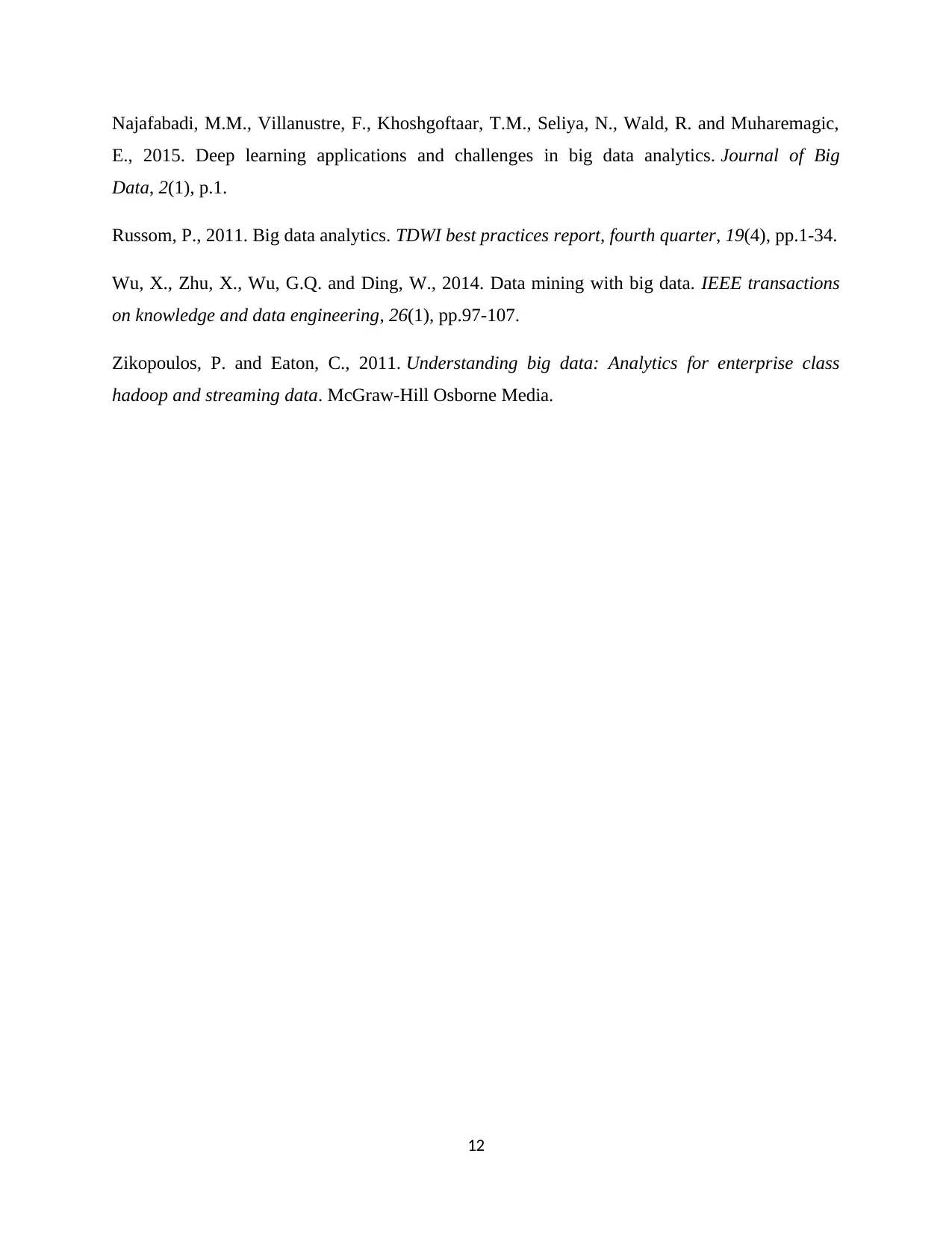
Najafabadi, M.M., Villanustre, F., Khoshgoftaar, T.M., Seliya, N., Wald, R. and Muharemagic,
E., 2015. Deep learning applications and challenges in big data analytics. Journal of Big
Data, 2(1), p.1.
Russom, P., 2011. Big data analytics. TDWI best practices report, fourth quarter, 19(4), pp.1-34.
Wu, X., Zhu, X., Wu, G.Q. and Ding, W., 2014. Data mining with big data. IEEE transactions
on knowledge and data engineering, 26(1), pp.97-107.
Zikopoulos, P. and Eaton, C., 2011. Understanding big data: Analytics for enterprise class
hadoop and streaming data. McGraw-Hill Osborne Media.
12
E., 2015. Deep learning applications and challenges in big data analytics. Journal of Big
Data, 2(1), p.1.
Russom, P., 2011. Big data analytics. TDWI best practices report, fourth quarter, 19(4), pp.1-34.
Wu, X., Zhu, X., Wu, G.Q. and Ding, W., 2014. Data mining with big data. IEEE transactions
on knowledge and data engineering, 26(1), pp.97-107.
Zikopoulos, P. and Eaton, C., 2011. Understanding big data: Analytics for enterprise class
hadoop and streaming data. McGraw-Hill Osborne Media.
12
⊘ This is a preview!⊘
Do you want full access?
Subscribe today to unlock all pages.

Trusted by 1+ million students worldwide
1 out of 12
Related Documents
Your All-in-One AI-Powered Toolkit for Academic Success.
+13062052269
info@desklib.com
Available 24*7 on WhatsApp / Email
![[object Object]](/_next/static/media/star-bottom.7253800d.svg)
Unlock your academic potential
Copyright © 2020–2025 A2Z Services. All Rights Reserved. Developed and managed by ZUCOL.




